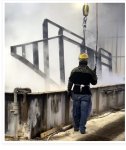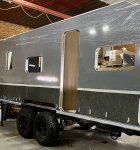Treefarmer
Active member
The flooring is (1)puncture resistant fiberglass, (2)Azdel, (3)1/2' foam layer before aluminum frame (4)1.5" high density foam ib between aluminum frame, (5)Azdel, (6)hard fiberglass skim with screw retention, and finally (7) dog-proof industrial linoleum. There is an aluminum framework holding the floor together and adding maximum strength at joints with walls etc. Not as thick as the walls, but we do have heat vented under the floor as well.Really liking the cabinets and flooring. What materials are your using for these components?
The cabinets are a teak wood grain polyethylene. They are strong, light and hold a screw well. We have solid oak everything now. It's strong and durable, but way too heavy for our new trailer.


